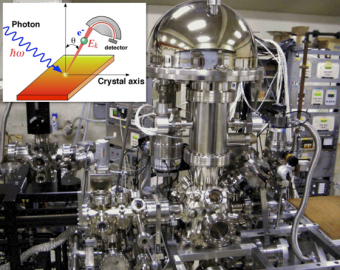Topics
2018.10.16
Angle-resolved photoemission study of novel functional materials
Photoemission Solid-State Physics
Our group uses angle-resolved photoemission spectroscopy (ARPES) based on the light quantum hypothesis proposed by Einstein. When materials are irradiated with light (photons), electrons (photo-electrons) are emitted from the surface via the external photoelectric effect. We observe these photo-electrons with a state-of-the-art ultrahigh-resolution photoemission spectrometer constructed in our laboratory (Fig. 1) and elucidate the electronic states of various novel materials such as topological insulators and high-temperature superconductors. ARPES is now a central experimental technique in condensed-matter physics, with which we are able to observe directly the energy band structure of materials.
FIG 1: Ultrahigh-resolution ARPES spectrometer constructed in our lab. Inset shows the principle of ARPES
For more than two decades, we have been devoted to the development of ARPES spectrometer, and succeeded in improving dramatically the performance of spectrometer, for example, achieving an ultrahigh energy resolution. By utilizing this state-of-the-art spectrometer, we are able to directly observe even a very small superconducting gap of various novel superconductors and unveil the superconducting mechanism (Fig. 2). We also investigate various atomic-layer materials represented by graphene, and explore the exotic physical properties such as superconductivity. Moreover, by developing a new spin-resolved ARPES spectrometer capable of resolving the three key physical parameters of electrons in materials, i.e., energy, momentum, and spin, we intensively study the electronic states of novel spintronic materials.

Fig.2 Superconducting gap of iron-based superconductor, and (bottom) the band structure and Fermi surface determined by ARPES
Here we show an example of ARPES study on topological insulators. Topological insulators host a novel quantum state of matter characterized by the unusual topological metallic surface states despite the insulating nature of bulk (Fig. 3). This surface state is composed of Dirac electrons with a peculiar characteristics distinct from ordinary electrons (Fig. 3). Dirac electrons in topological insulators are thought to be highly useful for advanced applications such as low-energy-consumption spintronic devices and quantum computer. We have succeeded in discovering several new types of topological insulators by directly visualizing the Dirac-cone energy dispersion by ARPES (Fig. 3). Discovery of such new types of topological materials plays a crucial role in accelerating the realization of exotic topological quantum phenomena and next-generation electronic devices.
Recently, we have started construction of a new nano-spin ARPES spectrometer which will be used in synchrotron facility. This machine achieves the highest spatial resolution in the world and enables us to determine very precisely the local spin-dependent electronic states. This new spectrometer will no doubt be a powerful tool to explore the origin and mechanism of anomalous properties in various novel materials.



